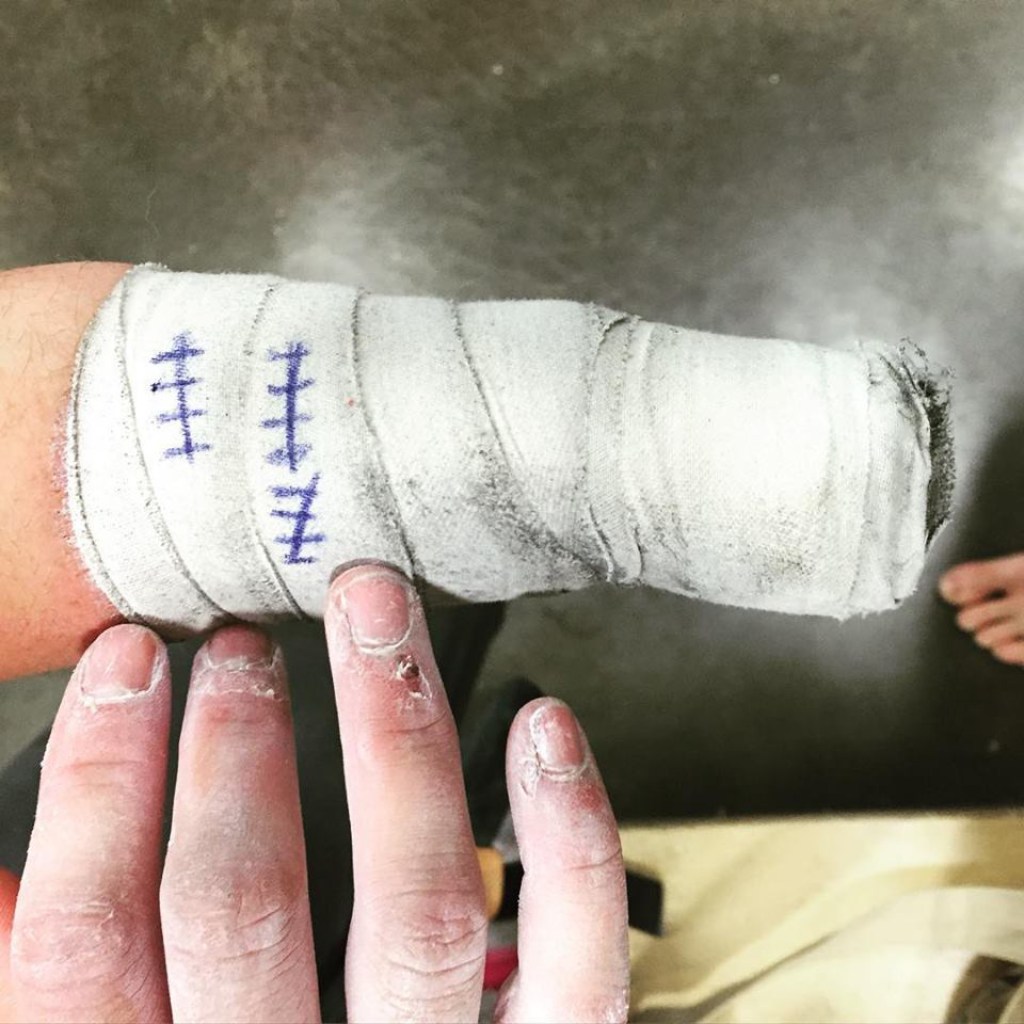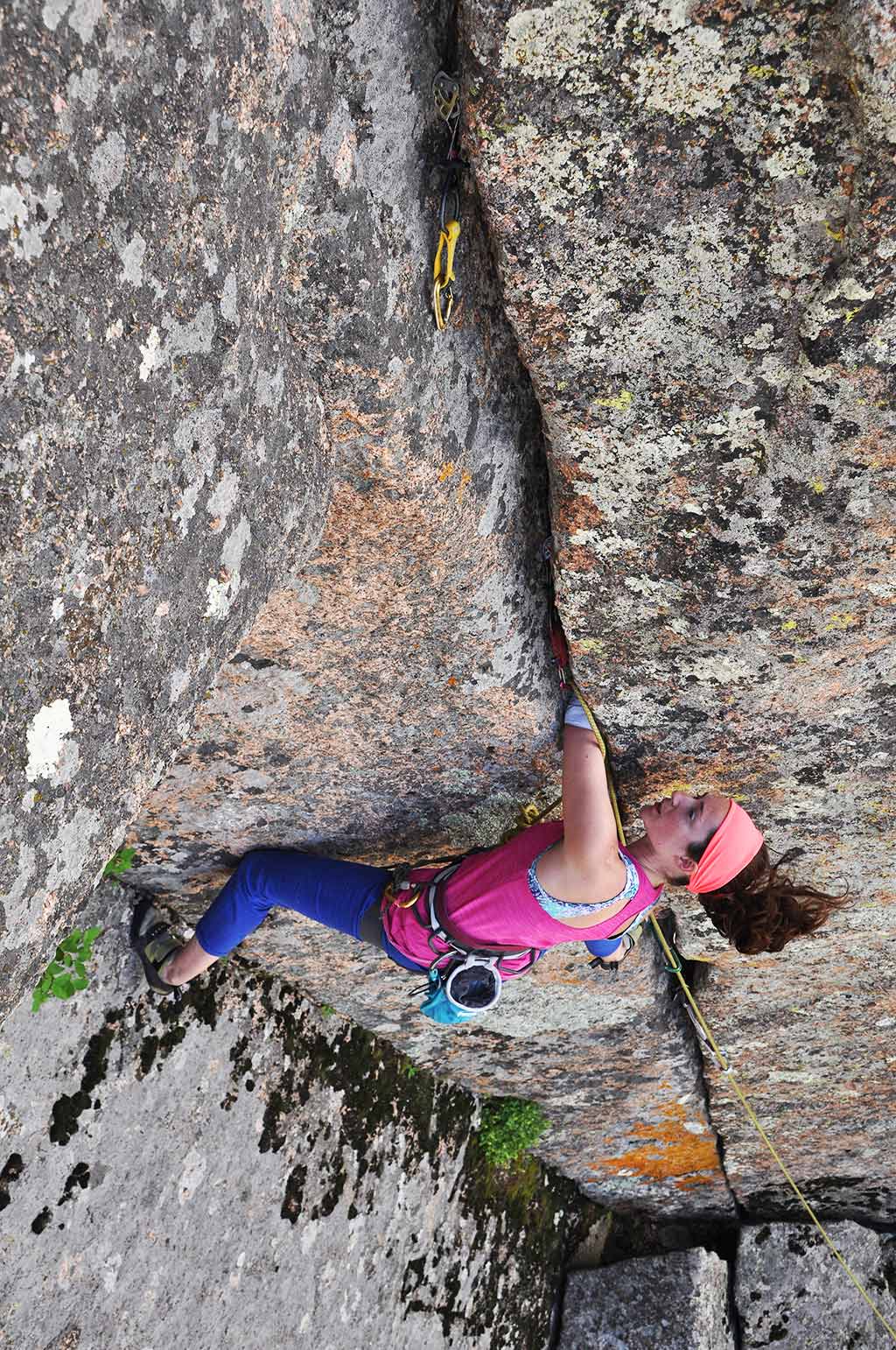Maureen Beck wants to show that adaptive athletes can climb as well as—or better than—anyone else.
Maureen Beck smears her toes on the smooth granite, greasy in the summer heat. She leans hard and twists, kicking her left foot along the gray, slightly overhanging wall.
“You got it, Mo!” her partner, Eamon Swihart, hollers from below.
Her right fingers find purchase in a slick seam, and she squeezes a sloping rail with the taped-up bit of her arm that remains below her left elbow—she calls it “my stump.” Arms spanned completely, she is a vice. She maneuvers her feet higher, sticking to microscopic quartz crystals by magic alone. For a moment, it seems she rewrites the laws of friction and of physics.
Searching for her next movement, a brief hesitation disrupts her flow and the slippery granite spits her off. She lets out a frustrated sigh. She’s fought with everything she has for every inch of progress, and she knows she can—she will—make her way higher still.
Mo was born without her left hand and most of her left forearm. She’s won the IFSC World Paraclimbing Championships twice—in 2016 and 2014— and more than a half-dozen national-level climbing competitions. She works a day job as a sales coordinator at Eldorado Climbing Walls, and in her off-time serves as an ambassador for Paradox Sports, a nonprofit that uses climbing to change what’s perceived as possible for individuals with disabilities.
She’s projecting Days of Future Passed, a sport climb in Boulder Canyon, and her first 5.12. When I meet her at the cliff, it’s come down to one section: a couple moves in a flaring finger crack.
“My stump doesn’t fit anything below tight .75 [camalots],” she tells me, and this crack doesn’t fit anything larger than a .4—just barely enough to slot her second knuckles.
But she’s used to navigating her way around the way most people climb, and discovering her own, intricate beta.
In the evening shade, she puts on her sweater. It reads, “LISA CLIMBING,” in bold letters across her back. The printing company had botched the design for the USA adaptive climbing team’s clothing for world championships—LISA instead of USA. She still wears hers anyway.
The sun’s long gone now, and she’ll need a headlight to navigate back down the hill.
“One more go,” she says, as she ties back in for the day’s final attempt at the route.
***
I talked with Mo about how climbing has impacted her life, the challenges she’s faced and her relationship with the adaptive climbing community. Here she is in her own words:
My parents never called me disabled. They never called me handicapped. They never coddled me in any way, shape or form. Once or twice my parents were like, “Hey, here’s this special basketball camp for kids with disabilities. You don’t want to go, do you?” And I said, “No, you’re right, I don’t want to go.” They signed me up for soccer—I played goalie—and Girl Scout camp. They made me learn to tie my shoes, cut my meat, everything. There were no excuses.
I started climbing at 12 or 13 with the Girl Scouts. It was in middle-of-nowhere Maine, and they had these big boulders the size of houses. They had a single bolt, and a counselor would take the rope in one hand and scramble up. Knowing what I know now, it was kind of sketchy. But it was a really cool way to get girls out there climbing. They didn’t tell me I couldn’t do it. They were just like, “Yep, tie in. Go.”
Climbing’s one of those things that’s perceived as being really hard with one hand. And it is. But it stuck with me for the same reasons that everybody else loves climbing. It gets you outside, it gets you pushing yourself and it’s a sport where everyone fails a lot before those brief, amazing moments of success.
I’m differently-abled. The language that we use for describing ourselves sets the standard for how we’re perceived, and what we believe we’re capable of.
Grades don’t matter. Especially when you have one hand. But I feel like 5.12 is this line that separates the weekend climber from someone who is really trying. That’s the line for able-bodied people, and if I can do it as a differently-abled person, that will mean a lot.

Counting training laps at the gym | Photo: Brian Beck
The first climb I ever projected was Reefer Madness [5.11a] in Clear Creek. It’s a techy, pretty steep face climb. Since it was more technique-oriented, I could figure out my own beta. There were lots of hours staring at this blank-ish section of rock and trying to work my way through, but once it clicked, it didn’t feel hard anymore. I think it’s really cool to take something that feels impossible and make it feel like I can do it.
I have to get creative. For example, you can find the teeniest crimp, turn it upside down, and I can shove my stump up into that, like an undercling. So I’ll tick things, and I can see people work on my climb after me and be like, “What’s this tickmark for? I can’t use this!”
Clipping can be tough. There are probably 5.7s I can never lead safely, because there’s a big left clip, and I just can’t reach it. I’m pretty good at working my way around stuff, but it’s a big learning process. I have to think, “It’s OK I can’t do that one. Good thing there are a million other climbs out there.” Letting go can be tough. I play a lot with longer draws. The crux of the climb I’m working on now [Days of Future Passed] has this big, wide right clip. With my stump in the sidepull, I’m about eight inches too short. We’re experimenting with taping a long draw across the rock.
Paradox Sports is a nonprofit that works with people with disabilities to get them outside climbing. It takes a community-based approach and uses climbing as a vehicle for empowerment. It’s kind of corny, but they make dream comes true. They want to teach participants not to just be participants. Paradox likes to teach you how to tie knots, teach you how to belay. After the event’s over, you can take your friends climbing. I like that idea of enabling participants, not just serving them.
I was born this way. I didn’t lose anything. I think people that did lose something can see me and think, “Well shit, she’s been doing it her whole life, so maybe this isn’t that bad.” I think that’s where what we call “OGs”—original gimps—can demonstrate things. Like, “Yeah, I can tie my shoes. Not a big deal. I made it this far in life.” The Paradox events are as much about the non-climbing parts as the climbing. It’s getting to know each other and getting to learn from each other.
The first adaptive event I ever did was called “Gimps on Ice.” I’d put off identifying with the adaptive community for a long time. I thought they were all touchy-feely and treated everyone like they’re special, like at the camps I didn’t want to go to. But with this event, I thought well, if the word “gimp” is in the title, these guys might be OK. It was in Ouray and put on by Paradox Sports. I went, and people climbed hard all day. Like really hard. And they didn’t quit at night. There was a big party after, a big kegger, and we drank heavily together. I thought, “Man, these are my people.” It sounds funny, but it’s true.
World Cup competition is like a fun family thing. The next one is in Scotland, and I need to be in the best shape of my life. Everybody wants to win, obviously, but really the competition is almost second. There’s this bigger picture to it all. Because we all do things differently, we’re able to learn from each other a little more than able-bodied climbers swapping hangboard tips. It’s more deep and intimate than that.

Climbing a hand crack in Vedauwoo, WY | Photo: Timpson Smith
If I’m not climbing, I’m usually fly fishing. My husband’s not a climber; he’s a fisherman. So every time I go fishing I call it my “stay-married day.”
When my husband and I started dating in college, he told me he had all this climbing experience since he was from Colorado. But it took weeks before he finally went climbing with me. It turned out, he hates to climb. But by then, it was too late. I liked him.
I had a prosthetic, mostly for aesthetics. I realized I can do more without it. It’s not comfortable. It’s hot and sweaty. I would equate it to walking around in your ski boots. You can, but why would you want to? I just stopped wearing it and haven’t really looked back since.
There’s a pressure on disabled athletes. We’re put on this pedestal. We’re supposed to inspire people. We’re supposed to always be shiny and successful. It really bugs me at a gym, when I goof off and I fall on a climb that’s really easy and someone says, “Wow, that’s amazing, you’re great!” No I’m not; don’t say that.
It’s about the community and the approach at Paradox. Someone can call us and say, “I have one leg.” We say, “So what? We work with 20 other people who have one leg. You’re not that special.” That’s why I’ve fallen in with the adaptive community—because I’m not special anymore. I’m not the one girl at the gym everyone’s oohing and aahing over. I think that’s my bigger dream, that one day there are so many adaptive climbers I can walk into any gym and not get a look. I want to normalize the abnormal.
Once I’m off my sport kick, I wouldn’t mind getting more into offwidth. I’ve identified how small of a crack I can climb, but not how big. I think that’ll be my next project.
I’ve definitely come around to the idea that you wouldn’t be talking to me if I had two hands. No one cares if a random chick climbs 5.12. I think it just lets me spread my message—anyone can climb and everyone should climb. People can have a disability and not just succeed for a warm and fuzzy feeling, but actually get out there and kick some ass.
